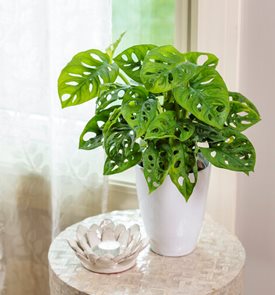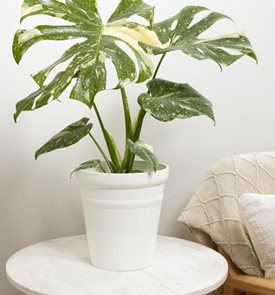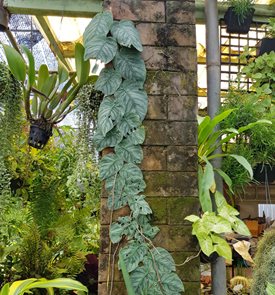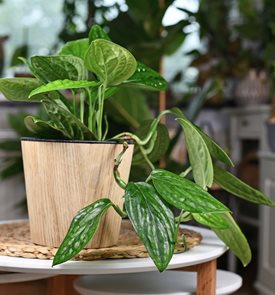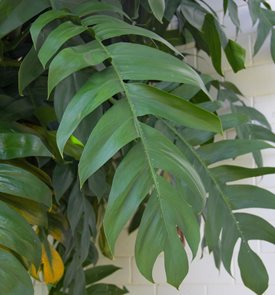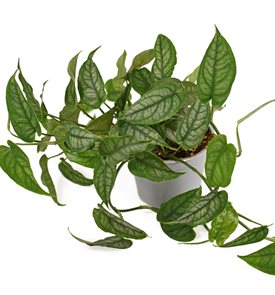A Guide to Growing Monstera
Grow and care for this favorite of avid houseplant collectors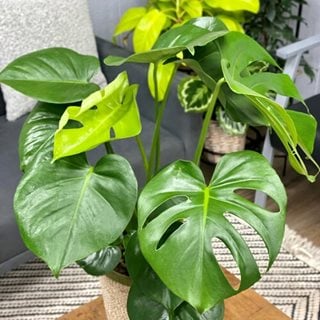
Mysteria® Deliciosa Swiss Cheese Plant. Photo by: Proven Winners
Houseplant enthusiasts have fallen head-over-heels for Monstera, which is grown for the leaves that develop holes or deep slits, creating an exotic look. Rare varieties or prime specimens can fetch hundreds or thousands of dollars. For the casual houseplant grower, there are many types of Monstera that are easy to grow and budget-friendly.
Monstera comes in a variety of leaf sizes, shapes, and patterns to complement any home or office decor. This versatile indoor plant can be kept compact, grown up a support, or allowed to trail in a hanging container. Uplift your spirits during the dreary days of winter by adding a living tropical touch to your indoor environment.
Here’s how to grow these fascinating plants:
On this page: Basics | Growing Tips | Care and Maintenance | How to Propagate | Pictures | Troubleshooting & FAQ's | Display Ideas
On this page:
- BASICS
- GROWING TIPS FOR MONSTERA
- MONSTERA CARE AND MAINTENANCE
- MONSTERA VARIETIES
- TROUBLESHOOTING
- DISPLAY IDEAS
BASICS
Botanical name:
Monstera spp.
Common names:
Swiss cheese plant, split-leaf philodendron, hurricane plant, Mexican breadfruit
Origin:
Native to tropical rainforests of Central America
Zones:
Usually grown indoors as a houseplant, but can be grown outside in Zones 10-12
Plant care level:
Easy to moderate
Growth rate:
Slow to fast depending on the variety
Foliage:
Varies, depending on variety. Many develop deep slits or holes, while some species remain solid. Coloring is green or with variegated patterns of green, silver, white, or cream.
Flowers:
Rarely blooms indoors.
Roots:
Brown rope-like aerial roots develop along the stems. Lower roots can be tucked into the soil to nourish and strengthen the plant, while upper roots can be attached to climbing structures or allowed to grow freely.
Habit and size:
Bushy or vining habit. When grown as a houseplant, plants can grow 3 to 20 feet tall and 1 to 3 feet wide.
Is Monstera toxic?
Monstera contains calcium oxalate crystals, which are toxic to pets and humans. Plant sap can cause skin irritation or rashes in adults and children. (See more Common Poisonous Plants for Dogs and Cats.)
Monstera lookalikes:
Plants that look similar to Monstera include mini monstera (Rhaphidophora tetrasperma) and pothos (Epipremnum spp.). Split-leaf philodendron (Philodendron bipinnatifidum) is sometimes confused with Monstera because of its close resemblance and mutual common name.
MONSTERA GROWING TIPS
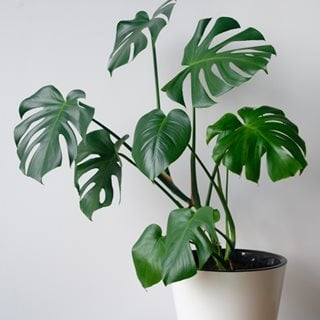
Photo by: Sozina Kseniia / Shutterstock
How much light does a monstera need?
Place near a window that gets bright indirect light/sunlight. Avoid direct sunlight, which can scorch the leaves. Plants can be set outdoors in an open shady spot during warmer months in summer.
Temperature:
Ideal temperature is between 65 to 85 degrees F. Temperatures below 55 to 60 degrees can cause plant stress or death. Keep plants away from heating vents and cold drafts.
Humidity:
Houseplants will do best with room humidity of at least 60%. Boost humidity by using a room humidifier, misting plants frequently, or setting pots on a shallow tray filled with pebbles and water. Make sure the bottom of the pot doesn’t sit in standing water to avoid root rot.
Soil type:
Monstera thrives in aerated soil that drains well, with a slightly acidic to neutral pH between 5.5 and 7.0. Use a soil especially formulated for growing Monstera, or use a high-quality potting mix, adding coco fiber and perlite or orchid bark to improve drainage.
Pot requirements:
Grow in a pot that is 2 to 4 inches wider and deeper than the root ball, with adequate drainage holes. Avoid planting in a container that’s too big to help prevent root rot. Make sure the pot is wide and deep enough to accommodate a moss pole or other support.
Support:
To encourage plants to climb, Monstera is often trained on a support known as a moss pole and provide the ideal surface for aerial roots to attach.
MONSTERA CARE
How often do you water a monstera?
Water every 1 to 2 weeks, or whenever the soil feels dry 2 inches down. Allow plants to dry out in between waterings. Avoid overwatering, which can cause root rot. Reduce watering during fall and winter.
Fertilizing:
Apply a balanced 20-20-20 liquid fertilizer monthly during the growing season, from mid-March to November. Cease fertilizing in winter when plant growth slows down.
Pruning:
Plants can be kept bushy or allowed to climb. Trim back to desired size in spring when there is active growth. Save leaf cuttings to propagate into new plants. Remove any damaged or old leaves as needed to divert energy back into the plant.
Cleaning:
Wipe leaves with a damp cloth every few months to keep foliage looking fresh.
Repotting:
Plants can be repotted every 1 to 3 years, or whenever they become rootbound. Repot in spring before new growth resumes. Choose a pot 2 to 4 inches larger than the previous container. Remove old potting soil from roots and refresh with new soil, covering the base roots and lower aerial roots.
Pests:
The most common pests are aphids, scale, mealybugs, thrips, or fungus gnats. Remove pests from affected areas with a cotton swab dipped in 70% rubbing alcohol. For larger infestations, use insecticidal soap or Neem oil. Reapply treatment as needed. Isolate plants away from other plants until you’re sure the pests are eliminated. (See more on common houseplant pests.)
HOW TO PROPAGATE MONSTERA
Monstera is most commonly propagated through cuttings or division. The best time of year to propagate is during spring and summer when plants are actively growing.
Stem cuttings:
This is the most common and easiest form of propagation. Trim off a stem that has at least one healthy leaf and a node. Place cuttings in water until new roots develop, which can take up to several months. Change out water weekly to prevent bacteria from forming. Pot up rooted cuttings in fresh soil. Fresh cuttings can also be planted directly into soil.
Root division:
Remove plant from pot and rinse soil from the roots. Separate sections by pulling them apart or clipping away from the main root system. Repot into fresh soil.
MONSTERA VARIETIES
TROUBLESHOOTING
When given optimal growing conditions, monstera has few problems. Look for these possible symptoms:
- Stunted growth may be an indication that room temperature is too cold or humidity is too low. It also may be a result of an inferior growing medium or lack of fertilizer. Adjust growing conditions accordingly.
- Yellow leaves can be due to a variety of factors, including improper watering, poor drainage, lack of light or nutrients, low temperatures, or environmental changes. It also may be a sign of pests such as mealybugs, thrips, or spider mites. It’s normal for some of the lower leaves to turn yellow and drop as the plant develops new foliage. Evaluate plants and remedy as needed.
- Brown leaf tips can be a sign of underwatering or low humidity. Increase one or both as needed.
- Droopy leaves can be caused by a lack of water or nutrients, extreme hot or cold temperatures, root rot, transplant shock, crowded roots, or pests such as spider mites or scale. Adjust conditions as needed.
- Leggy growth may result from too little light or fertilizer. Move plants to brighter light or increase fertilizing as needed.
- Blackened leaves can indicate root rot, which is caused by overwatering or poor drainage. Plants can die quickly if the problem isn’t addressed. Remove the plant from its pot and inspect the roots. Cut out blackened or rotted roots. Transplant into a new pot with fresh potting soil, making sure there is good drainage. Don’t overwater, and provide adequate light and humidity.
- Brown spots surrounded by a yellow halo may be a sign of fungal disease. This is usually caused by overwatering or poor air circulation. Remove affected leaves, reduce watering, and move to a spot with better air circulation, though it’s important to keep plants away from drafts.
- Lack of leaf fenestration (holes or slits) can simply be due to a plant’s age. Swiss cheese plant needs to be 2 or 3 years old before the leaves develop holes or splits. Other species such as Swiss cheese vine will fenestrate when they are younger. Lack of sunlight, water, or fertilizer can also be factors. Plants may grow larger leaves with more fenestration when given vertical support.
DISPLAY IDEAS
- Keep a larger specimen pruned as a bush form and display on the floor of a spacious entryway or office lobby.
- Allow a vining form to grow horizontally along a mantle, bookshelf, or wall for a unique living accent.
- Use a moss pole, decorative trellis, or other support to train into a vertical accent to liven up a bright corner of a room.
- Keep a smaller specimen pruned in a compact bush form and display on an end table or dining room table.
- Display leaf cuttings in a grouping of small clear vases so you can watch the roots grow.
- Allow a smaller specimen to trail in a hanging basket in a bathroom or kitchen that receives more air humidity.
- Grow a small specimen in a terrarium along with other tropicals with similar needs.
RELATED:
21 Best Indoor Plants
Best Low-Light Houseplants
A Guide to Growing Pothos
The Best Philodendrons to Grow Indoors

